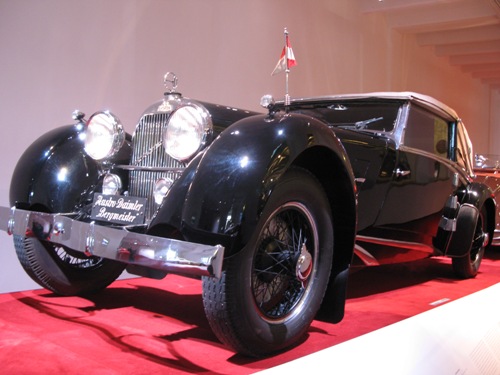
Gräf & Stift SP 8 Pullman-Limousine
1930
Heydays usually signal the end of an era. And indeed, it was in August 1929, only a few weeks before the Great Depression, that Gräf & Stift launched its SP 8. Up until 1933, the company based in Döbling, Vienna, manufactured 30 of these six-litre eight-cylinder automobiles with a curb weight of over three tones. But as the world’s financial markets collapsed, few people wanted – or could afford – to invest in all too exclusive cars. What remains is an engineering manifest that pays impressive testimony to the heights once achieved by the Austrian car-making industry. The luxury car with the famous bronze lion as its radiator emblem was certainly the equal of the leading marques of the time in both technology and equipment. But as a small company Gräf & Stift only survived the crisis years at considerable cost. Expensive in-house developments were shelved in favour of licensed, and with the “Anschluss” of 1938 automobile construction at Gräf & Stift was well and truly over. The history of this SP 8 remains an impressive testimonial of the times. This automobile with its elegant Pullman finish was never sold; that is to say, no buyer ever came forward due to the tense economic situation. The vehicle remained at the works and was used by its managing director Josef Gräf, the son of the company founder Carl Gräf, as a company car. During World War II and the post-war period, it was dismantled, its components hidden on the company premises, out of sight of the occupying forces.

Bugatti Typ 51 Grand Prix
1931
Ettore Bugatti's thoroughbreds had no reason to shy any comparison with a full-blooded racehorse. Next to their rivals on the historical starting photos they seemed slender, elegant, and almost delicate. Bugatti, the offspring of a family of artists from Milan, regarded the automobile as a complete work of art which had to be both a technical masterpiece and a sculpture in motion. But above all, these mostly blue-liveried racing cars with their distinctive horseshoe radiator achieved their purpose, namely to win races. One of these winning types from the Alsace car factory, which competed in races between 1931 and 1935, was the Bugatti 51.
The young Bohemian nobleman Jirí Kristián Lobkowicz acquired such an automobile in August 1931 after winning a number of mountain races the previous years as a private driver at the wheel of a Bugatte 35C. On September 27, only a few weeks after acquiring his new car, he came fourth in his first home Grand Prix at the Masaryk Ring near Brno, competing against the driving elite of his day. It was, however, to be his only race in that car, for in May 1932, aged only 25, he was killed in a fatal accident at the Berlin AVUS while driving a Bugatti 54.
Zdenek Pohl, Lobkowicz’s stable mate and friend, acquired the car after the tragic accident. But he was force to withdraw in each case from the two Grand Prix races he entered in Brno in 1934 and 1935.

Austro-Daimler Bergmeister
Spezial-Cabriolet
1932
Right into the 1920s, the trinity of Austria, automobile construction, and motorsport proved a successful combination. Indeed domestic automobile manufacturers regarded participation in mountain races as an excellent means of promoting their products. There were innovative engineers at hand, and daredevil pilots competing fiercely to join the works teams. The name given to the Austro-Daimler ADR 120 underlines the inseparable link that existed between events on the race tracks and the series manufacture of automobiles. The name Bergmeister goes back to one of the most prestigious title held by the works driver Hans Stuck, who was virtually unbeatable on his ADM R between 1927 and 1930. The "King of the Moutains" claimed no fewer than 43 victories in mountain races throughout Europe. His record of 6:13.56 established in 1930 on the 10 km Semmering mountain section has held to this day. The same year, Austro-Daimler retired from motor racing, and Hans Stuck moved to Mercedes-Benz, his rival of many years. For all the vehicle’s qualities, the advertising strategy which consisted of using the name to transfer the sporting image gained from racing successes to the new series sports-bodied luxury car failed due to the economic recession that prevailed in the early 1930s. From 1932 onwards, only 20 ADR Bergmeisters went into production, with an evolved ADM racing engine and a reinforced centre-tubular chassis from its predecessor, the ADR 11/70. The last Bergmeister, a custom design cabriolet, was delivered in 1937.
